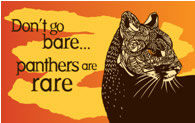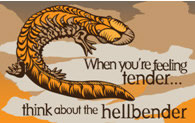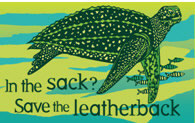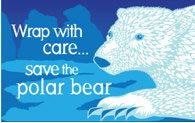100,000 Endangered Species Condoms to Be Given Away for Earth Day
Project Highlights Tie Between Human Overpopulation, Global Extinction Crisis
March 27 , 2012 - TUCSON, Ariz. - The Center for Biological Diversity will
mark this year's Earth Day by distributing 100,000 free Endangered Species Condoms around the
country. The Center collaborated with artist Roger Peet to create
a special edition of the colorful condom packages featuring a suite of species - from the dwarf seahorse to the polar
bear - threatened by the world's growing human population.
"The more people we crowd onto our planet, the fewer resources there are for already-endangered species
like panthers, sea turtles and snowy plovers," said Amy Harwood, who runs the Center's human population campaign. "If we're
going to deal with why plants and animals are going extinct at a staggering rate, we have to make human overpopulation part
of the conversation."
The Center expects to get thousands of volunteers to distribute Endangered Species Condoms in all 50 states as
part of Earth Day on April 22. In the past, the condoms have been given away at community events, libraries, college dorms,
protests, bars and backyard parties. "These condoms are a great way to get people talking and thinking about how
overpopulation's hurting plants and wildlife that people care about," Harwood said.
The world's population has doubled since 1968 and surpassed 7 billion in October 2011. The United
Nations predicts it will top 10 billion by the end of this century. Meanwhile, about 90 species go extinct every day.
The Center is the only environmental group with a full-time campaign highlighting the connection
between unsustainable human population growth and the ongoing extinction crisis for plants and animals around
the world. Since 2010, the Center has handed out nearly 500,000 free condoms as a part of
the 7 Billion and Counting campaign.
The Center has used the Endangered Species Condoms project to collaborate with artists and graphic
designers. "Including Roger Peet in this project made sense. He has devoted his art to raising awareness about
the species extinction crisis," said Harwood.
The new condom packages highlight six imperiled species:
 FLORIDA PANTHER ("Don't go bare, panthers are rare.")
A predator of enormous physical grace and power, the Florida panther is one of the most majestic large felines in the wild. But
while Florida's human population nearly doubled over the past 30 years, the panther's numbers have plummeted. As the coasts
become more crowded, Florida development is increasingly moving inland, coming into direct conflict with panthers. FLORIDA PANTHER ("Don't go bare, panthers are rare.")
A predator of enormous physical grace and power, the Florida panther is one of the most majestic large felines in the wild. But
while Florida's human population nearly doubled over the past 30 years, the panther's numbers have plummeted. As the coasts
become more crowded, Florida development is increasingly moving inland, coming into direct conflict with panthers.
 DWARF SEAHORSE ("Safe intercourse saves the dwarf seahorse.")
This inch-tall, curly-tailed fish occurs only in shallow seagrass areas in the Gulf of Mexico, along the Atlantic coast of Florida and in the Caribbean.
Unfortunately, as the Gulf gets more crowded and industrialized, this seahorse faces more threats to its existence. Widespread
loss of seagrass habitat due to pollution, boat damage and global warming is pushing this minuscule creature to the brink. DWARF SEAHORSE ("Safe intercourse saves the dwarf seahorse.")
This inch-tall, curly-tailed fish occurs only in shallow seagrass areas in the Gulf of Mexico, along the Atlantic coast of Florida and in the Caribbean.
Unfortunately, as the Gulf gets more crowded and industrialized, this seahorse faces more threats to its existence. Widespread
loss of seagrass habitat due to pollution, boat damage and global warming is pushing this minuscule creature to the brink.
 HELLBENDER ("When you're feeling tender, think about the hellbender.")
Hellbenders may not be pretty, but at 2 feet long, they're North America's largest amphibian. Like many amphibians, the hellbender faces extinction from the strain that
the effects of human overpopulation (including pollution) put on our freshwater streams in the southeastern United States. HELLBENDER ("When you're feeling tender, think about the hellbender.")
Hellbenders may not be pretty, but at 2 feet long, they're North America's largest amphibian. Like many amphibians, the hellbender faces extinction from the strain that
the effects of human overpopulation (including pollution) put on our freshwater streams in the southeastern United States.
 WESTERN SNOWY PLOVER ("Be a savvy lover, protect the snowy plover.")
The western snowy plover, a pocket-sized shorebird, is surviving against the odds. Its habitat of open, sandy beaches is a prime target for increasingly destructive human
activity. Being small doesn't prevent plovers from playing a big role in beach ecosystems, but it does make them vulnerable to the unnatural disturbances that plague their home. WESTERN SNOWY PLOVER ("Be a savvy lover, protect the snowy plover.")
The western snowy plover, a pocket-sized shorebird, is surviving against the odds. Its habitat of open, sandy beaches is a prime target for increasingly destructive human
activity. Being small doesn't prevent plovers from playing a big role in beach ecosystems, but it does make them vulnerable to the unnatural disturbances that plague their home.
 LEATHERBACK TURTLE ("In the sack? Save the leatherback.")
As ancient as the dinosaurs, the leatherback sea turtle is the heaviest reptile on Earth. Leatherback turtles are dependent on seashores for their lifecycle. With half the world's
human population living within 100 miles of the coastline, their nesting grounds are severely threatened by development. LEATHERBACK TURTLE ("In the sack? Save the leatherback.")
As ancient as the dinosaurs, the leatherback sea turtle is the heaviest reptile on Earth. Leatherback turtles are dependent on seashores for their lifecycle. With half the world's
human population living within 100 miles of the coastline, their nesting grounds are severely threatened by development.
 POLAR BEAR ("Wrap with care, save the polar bear.")
An international icon of global warming, the polar bear is going extinct as the Arctic sea ice melts beneath its feet because of the greenhouse gas emissions of 7 billion people - especially
those in high-consumption nations like the United States. The bear was put on the U.S. endangered species list in 2008. POLAR BEAR ("Wrap with care, save the polar bear.")
An international icon of global warming, the polar bear is going extinct as the Arctic sea ice melts beneath its feet because of the greenhouse gas emissions of 7 billion people - especially
those in high-consumption nations like the United States. The bear was put on the U.S. endangered species list in 2008.
###
CONTACT:
Amy Harwood, (520) 260-7172
"Reproduced with permission - Center for Biological Diversity "
Center for Biological Diversity
|